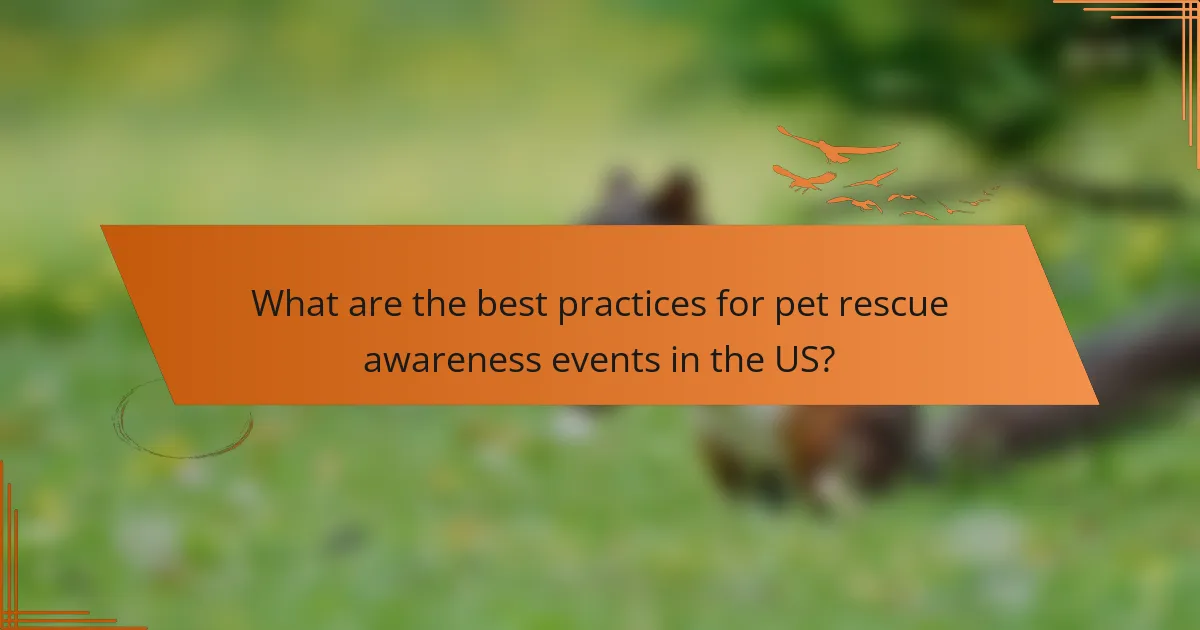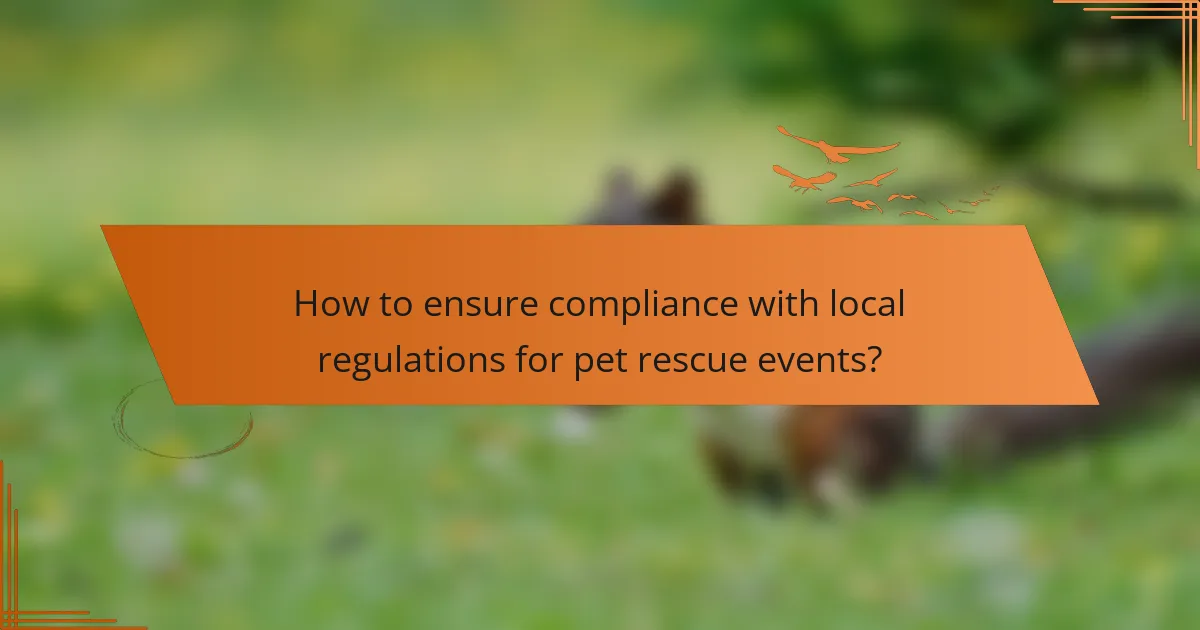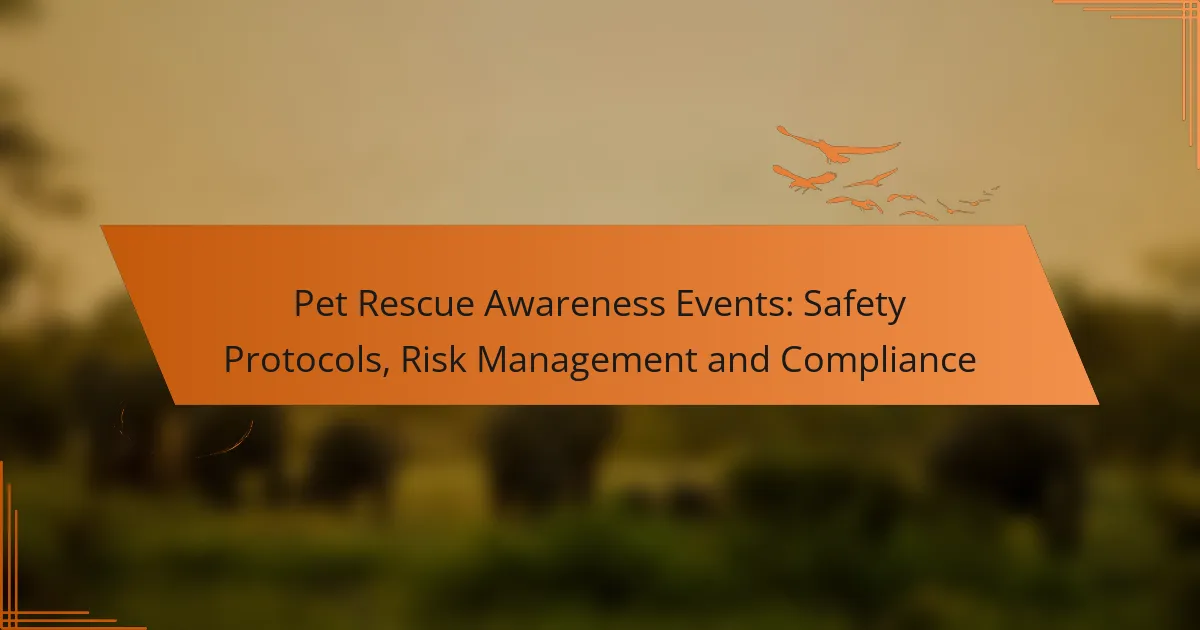Pet rescue awareness events play a crucial role in promoting animal welfare, but they require careful planning to ensure safety and compliance. By understanding local regulations, implementing risk management strategies, and establishing effective safety protocols, organizers can create a successful event that protects both animals and attendees. Prioritizing these elements not only enhances the event’s impact but also fosters a safe environment for all involved.

What are the best practices for pet rescue awareness events in the US?
Best practices for pet rescue awareness events in the US focus on thorough planning, participant safety, and effective emergency response. These practices ensure a successful event that raises awareness while minimizing risks to both animals and attendees.
Event planning guidelines
When planning a pet rescue awareness event, start by defining clear objectives, such as raising funds or increasing community engagement. Choose a suitable venue that is accessible and has adequate space for activities, vendors, and animals.
Develop a detailed timeline that includes key milestones, such as securing permits, arranging for veterinary services, and coordinating with local shelters. Collaborate with volunteers and local businesses to enhance the event’s reach and resources.
Safety measures for participants
Implement safety measures to protect both participants and animals during the event. Ensure that all animals are up-to-date on vaccinations and are handled by trained personnel. Provide clear signage to guide attendees and designate specific areas for pet interactions.
Consider having a first aid station staffed by qualified personnel to address any minor injuries or health concerns. Encourage participants to keep their pets on leashes and monitor their behavior to prevent any incidents.
Emergency response protocols
Establish emergency response protocols to handle potential incidents effectively. Create a clear communication plan that includes emergency contacts and procedures for reporting issues. Ensure all staff and volunteers are trained on these protocols.
Identify nearby veterinary clinics and emergency services in advance, and share this information with attendees. Conduct a brief safety briefing at the start of the event to inform participants about emergency exits and procedures in case of an incident.

How to ensure compliance with local regulations for pet rescue events?
To ensure compliance with local regulations for pet rescue events, it is essential to familiarize yourself with the specific laws and requirements in your area. This includes understanding animal welfare laws, obtaining necessary permits, and adhering to safety protocols to protect both animals and participants.
Understanding local animal welfare laws
Local animal welfare laws dictate how pets are treated during rescue events, including their care, housing, and transportation. These laws vary by region, so it is crucial to research the specific regulations in your locality to avoid penalties.
Common aspects of these laws may include guidelines on the minimum standards of care, restrictions on the types of animals that can be rescued, and requirements for veterinary care. Familiarizing yourself with these regulations helps ensure that your event operates within legal boundaries.
Permits and licenses required
Most regions require specific permits and licenses for pet rescue events, which may include event permits, animal handling permits, and health inspections. Start by contacting your local government or animal control agency to determine what is necessary for your event.
In many cases, you may need to submit applications well in advance, sometimes several weeks before the event. Ensure all documentation is complete and accurate to avoid delays. Additionally, consider checking if there are any fees associated with obtaining these permits, as they can vary significantly by location.

What risk management strategies should be implemented?
Implementing effective risk management strategies for pet rescue awareness events involves identifying potential hazards, securing appropriate insurance, and establishing safety protocols. These strategies help ensure the safety of participants, animals, and the event’s overall success.
Identifying potential hazards
Identifying potential hazards is crucial for minimizing risks at pet rescue events. Common hazards include aggressive animals, trip hazards from equipment, and adverse weather conditions. Conducting a thorough site assessment before the event can help pinpoint these risks.
Consider creating a checklist to evaluate the venue for safety concerns. Look for uneven surfaces, inadequate lighting, and areas where animals might escape. Engaging volunteers to assist with hazard identification can enhance the thoroughness of this process.
Insurance options for events
Choosing the right insurance coverage is vital for protecting against liabilities during pet rescue events. General liability insurance is often the most essential type, covering injuries to attendees and damages to property. Additionally, consider event cancellation insurance to safeguard against unforeseen circumstances that could disrupt the event.
When selecting an insurance provider, compare policies based on coverage limits, exclusions, and premiums. It’s advisable to consult with an insurance agent who specializes in event coverage to ensure you meet all necessary requirements and adequately protect your organization.

How to engage the community in pet rescue events?
Engaging the community in pet rescue events involves creating awareness and fostering participation through effective communication and activities. By utilizing targeted marketing strategies and forming partnerships with local businesses, organizations can enhance their outreach and impact.
Marketing strategies for outreach
Effective marketing strategies are essential for raising awareness about pet rescue events. Utilize social media platforms to share compelling stories, images, and videos of pets in need, which can capture the attention of potential volunteers and donors. Consider running targeted ads to reach specific demographics that are likely to engage with animal welfare.
Additionally, creating eye-catching flyers and posters for distribution in local community centers, veterinary clinics, and pet stores can help spread the word. Hosting informational sessions or webinars can also educate the public about the importance of pet rescue and how they can contribute.
Partnerships with local businesses
Forming partnerships with local businesses can significantly enhance the success of pet rescue events. Collaborate with pet stores, grooming salons, and veterinary clinics to host joint events or promotions that benefit both parties. For instance, a local pet store might offer discounts on supplies for customers who donate to your rescue initiative.
Moreover, businesses can provide sponsorships or in-kind donations, such as food or supplies, which can reduce event costs. Building these relationships not only helps with resources but also increases visibility within the community, encouraging more people to participate in pet rescue efforts.

What are the key safety protocols for volunteers?
Key safety protocols for volunteers include proper training, the use of personal protective equipment, and adherence to established guidelines. These measures are essential to ensure the safety of both volunteers and the animals they assist during rescue events.
Training requirements for volunteers
Volunteers must undergo comprehensive training that covers animal handling, emergency response, and safety procedures. This training should be tailored to the specific types of animals being rescued and the environments in which volunteers will operate.
Regular refresher courses are recommended to keep volunteers updated on best practices and any changes in safety protocols. New volunteers should shadow experienced team members during their initial assignments to gain practical insights.
Personal protective equipment guidelines
Volunteers should wear appropriate personal protective equipment (PPE) to minimize risks. Essential items include gloves, masks, and sturdy footwear to protect against bites, scratches, and exposure to hazardous materials.
It is crucial to ensure that all PPE is properly fitted and maintained. Volunteers should regularly check their equipment for wear and tear, replacing items as necessary to ensure maximum protection during rescue operations.

How to measure the success of pet rescue awareness events?
Measuring the success of pet rescue awareness events involves evaluating participant engagement, feedback, and overall impact on community awareness. Key indicators include attendance numbers, social media interactions, and the effectiveness of outreach efforts.
Metrics for participant engagement
To gauge participant engagement, focus on metrics such as attendance rates, volunteer involvement, and social media engagement. For instance, tracking the number of attendees compared to previous events can highlight growth or decline in interest.
Additionally, consider measuring the duration of participant stay at the event. Engaged attendees typically spend more time interacting with activities and information booths. A simple survey can help assess how long participants remained and which activities drew their attention.
Feedback collection methods
Collecting feedback is crucial for understanding participant experiences and areas for improvement. Utilize methods such as post-event surveys, comment cards, and online feedback forms to gather insights. Aim for a response rate of at least 20-30% to ensure data reliability.
Incorporate both quantitative and qualitative questions in your surveys. For example, ask participants to rate their overall satisfaction on a scale from 1 to 5, and include open-ended questions for detailed feedback. This combination helps identify specific strengths and weaknesses of the event.

What are the emerging trends in pet rescue events?
Emerging trends in pet rescue events focus on enhancing engagement and fundraising through innovative strategies and technology. These trends aim to increase participation, streamline operations, and maximize resources to support animal welfare.
Virtual events and online engagement
Virtual events have gained popularity, allowing pet rescue organizations to reach a broader audience without geographical limitations. Online platforms enable live-streamed adoption events, webinars, and interactive Q&A sessions, fostering community involvement.
To effectively engage participants, utilize social media for promotion and create shareable content. Consider hosting virtual meet-and-greets with pets available for adoption, which can help potential adopters connect emotionally with animals.
Innovative fundraising techniques
Fundraising for pet rescue events is evolving with creative approaches like crowdfunding campaigns and peer-to-peer fundraising. These methods empower supporters to raise funds on behalf of the organization, expanding the donor base.
Consider organizing themed events, such as pet fashion shows or virtual trivia nights, where participants pay an entry fee. Offering tiered sponsorship opportunities can also attract local businesses looking to support animal welfare while gaining visibility.
Use of technology in event management
Technology plays a crucial role in streamlining event management for pet rescues. Tools for online ticketing, registration, and donation processing simplify logistics and enhance the donor experience. Platforms like Eventbrite or GiveLively can facilitate these processes efficiently.
Implementing data management systems allows organizations to track donor engagement and event performance. This information can inform future strategies, helping to optimize fundraising efforts and improve participant satisfaction.



